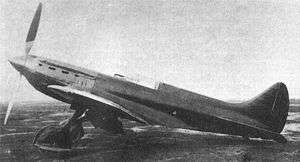Polikarpov I-17
The Polikarpov I-17 was a Soviet single-seat fighter prototype designed and built by a team headed by Polikarpov at the Central Design Bureau (TsKB)
| Polikarpov I-17 | |
|---|---|
 | |
| Role | Single-seat fighter |
| National origin | Soviet Union |
| Manufacturer | Polikarpov |
| First flight | 1 September 1934 |
| Number built | 3 |
Development
The I-17 was a lightweight single-seat low-wing cantilever monoplane. Developed under the design bureau designation TsKB-15 it first flew on 1 September 1934 powered by a 567 kW (760 hp) Hispano-Suiza 12 Ybrs engine. The second prototype designated the TsKB-19 had a revised inward retracting wide-track main landing gear and a Soviet M-100 engine. This second prototype was displayed at the 1936 Salon de l'Aeronautique in Paris. The third prototype designated the TsKB-33 had reduced armament to save weight and a revised engine cooling system, but the further development was abandoned in 1936.
A number of related unbuilt projects were also under development including the I-17Z parasite fighter under the designations TsKB-25 with a M-34RNF engine and the TsKB-43 with a Hispano-Suiza engine, none were built.
Variants
- TsKB-15
- First prototype I-17 powered by a 567 kW (760 hp) Hispano-Suiza 12 Ybrs engine.
- TsKB-19
- Second revised I-17 prototype powered by a M-100 engine.
- TsKB-25
- Unbuilt I-17Z project for a Mikulin AM-34RNF powered parasite fighter.
- TsKB-33
- Third revised I-17 prototype with reduced armament.
- TsKB-43
- Unbuilt project with a Hispano-Suiza engine.
Specifications (TsKB-19)
General characteristics
- Crew: 1 (pilot)
- Length: 7.30 m (23 ft 11 in)
- Wingspan: 10.19 m (33 ft 5 in)
- Height: 2.56 m (8 ft 5 in)
- Gross weight: 1,930 kg (4,250 lb)
- Powerplant: 1 × Klimov M-100 engine , 632 kW (860 hp)
Performance
- Maximum speed: 490 km/h (305 mph, 265 kn)
- Range: 800 km (497 mi, 432 nmi)
- Service ceiling: 11,000 m (36,090 ft)
Armament
Notes
References
- Angelucci, Enzo (1980). The Rand McNally Encyclopedia of Military Aircraft. Rand McNally Publishing. p. 183.
- Gunston, Bill (1995). The Osprey Encyclopedia of Russian Aircraft 1875-1995. London: Osprey. ISBN 1-85532-405-9.
- Taylor, Michael J. H. (1989). Jane's Encyclopedia of Aviation. London: Studio Editions.